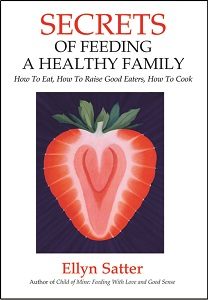
The Satter Feeding Dynamics Model
The Satter approach to feedingfdSatter
Children eat and grow well when parents feed according to a developmentally appropriate Satter Division of Responsibility in feeding (sDOR).1–3 The Satter Feeding Dynamics Model (fdSatter) illustrates that when parents follow sDOR, children grow up to become eating competent:4 They are sensible and joyful eaters. sDOR encourages parents to take leadership with the what, when, and where of feeding and let children determine how much and whether they will eat of what adults provide.1
What can eating competent children do?
- Feel good about eating and have the drive to eat.5
- Naturally eat the amount they need6–10 and grow in the way that is right for them.11–15
- Follow a predictable trajectory of development that guides feeding practice.16–18
- Apply their drive to grow up to learning to eat the food their parents eat.5,19–22
- Enjoy family meals and learn to behave well at mealtime.
Agencies recognize the division of responsibility in feeding as best practice
- The Academy of Nutrition and Dietetics.23–25
- The American Academy of Pediatrics.26,27
- Expert Committee on Child Obesity.28
- Head Start.29
- WIC: The Special Supplemental Nutrition Program for Women, Infants, and Children.30
- USDA Food and Nutrition Service.31
sDOR can soon be directly tested by sDOR.2-6yTM
An instrument for directly testing sDOR, the Satter Feeding Dynamics Inventory, sDOR.2-6yTM, has been developed based on cognitive interviewing.32 It has also been validated using videotaped parent-child interactions around feeding as well as comparison with other tools and nutritiional analysis. The validation work will soon be published. After that, it will be made available for use in research and clinical practice.
References
- Satter EM. The feeding relationship. J Am Diet Assoc. 1986;86:352-356.
- Satter EM. The feeding relationship: problems and interventions. The Journal of pediatrics. 1990;117:S181-S189.
- Satter EM. Feeding dynamics: Helping children to eat well. J Pediatr Health Car. 1995;9:178-184.
- Satter EM. Eating Competence: definition and evidence for the Satter Eating Competence Model. J Nutr Educ Behav. 2007;39:S142-S153.
- Davis CM. Self selection of diet by newly weaned infants: an experimental study. Am J Dis Child. 1928;36:651-679.
- Gesell SB. Feeding Behavior of Infants. Philadelphia: J.B. Lippincott; 1937.
- Fomon SJ, Thomas LN, Filer LJ, Ziegler EE, Leonard MT. Food consumption and growth of normal infants fed milk-based formulas. Acta Pædiatrica. 1971;60:1-36.
- Fomon SJ, Filer LJ, Jr., Thomas LN, Anderson TA, Nelson SE. Influence of formula concentration on caloric intake and growth of normal infants. Acta Paediatr Scand. 1975;64(2):172-181.
- NRC. National Research Council Recommended Dietary Allowances, 10th ed. Washington, DC: National Academy Press; 1989.
- Fomon SJ. Recommendations for feeding normal infants. In: Fomon SJ, ed. Nutrition of Normal Infants. St. Louis, MO: Mosby-Year Book, Inc.; 1993:455-458.
- Garn SM, Clark DC. Trends in fatness and the origins of obesity. Pediatrics. 1976;57:443-456.
- Hamill PV, Drizd TA, Johnson CL, Reed RB, Roche AF, Moore WM. Physical growth: National Center for Health Statistics percentiles. Am J Clin Nutr. 1979;32(3):607-629.
- Zack PM, Harlan WR, Leaverton PE, Cornoni-Huntley J. A longitudinal study of body fatness in childhood and adolescence. The Journal of pediatrics. 1979;95(1):126-130.
- Satter EM. Internal regulation and the evolution of normal growth as the basis for prevention of obesity in childhood. J Am Diet Assoc. 1996;96:860-864.
- Pietilainen KH, Kaprio J, Rasanen M, Winter T, Rissanen A, Rose RJ. Tracking of body size from birth to late adolescence: contributions of birth length, birth weight, duration of gestation, parents’ body size, and twinship. Am J Epidemiol. 2001;154(1):21-29.
- Greenspan SI. Fostering emotional and social development in infants with disabilities. Zero to Three: National Center for Clinical Infant Programs; 1988:8-18.
- Erikson EH. Eight ages of man. Childhood and Society, 2nd Edition. New York: W.W.Norton; 1993:242-274.
- Morris SE, Klein MD. Pre-feeding Skills–A Comprehensive Resource for Mealtime Development. San Antonio, Texas: The Psychological Corporation/Therapy Skill Builders; 2000.
- Birch LL, Marlin DW. I don’t like it; I never tried it: Effects of exposure on two-year-old children’s food preferences. Appetite. 1982;3:353-360.
- Birch LL. Children’s food preferences: Developmental patterns and environmental influences. In: Whitehurst G, Vesta Re, eds. Annals of Development. Greenwich, CT: JAI Press; 1987:171-208.
- Hendy HM. Effectiveness of trained peer models to encourage food acceptance in preschool children. Appetite. 2002;39(3):217-225.
- Addessi E, Galloway AT, Visalberghi E, Birch LL. Specific social influences on the acceptance of novel foods in 2-5-year-old children. Appetite. 2005;45(3):264-271.
- Butte N, Cobb K, Dwyer J, Graney L, Heird W, Rickard K. The Start Healthy Feeding Guidelines for Infants and Toddlers. J Am Diet Assoc. 2004;104(3):442-454.
- Nicklas TA, Hayes D. Position of the American Dietetic Association: Nutrition guidance for healthy children ages 2 to 11 years. J Am Diet Assoc. 2008;108(6):1038-1047.
- Ogata BN, Hayes D. Position of the academy of nutrition and dietetics: nutrition guidance for healthy children ages 2 to 11 years. Journal of the Academy of Nutrition and Dietetics. 2014;114(8):1257-1276.
- Krebs NF, Jacobson MS, American Academy of Pediatrics Committee on N. Prevention of pediatric overweight and obesity. Pediatrics. 2003/2007;112(2):424-430.
- Hagan JF, Shaw JS, Duncan PM. Bright Futures Nutrition, Guidelines for Health Supervision in Infants, Children, and Adolescents, 3rd ed. Elk Grove Village, IL,: American Academy of Pediatrics; 2008.
- Barlow SE, the Expert C. Expert Committee Recommendations Regarding the Prevention, Assessment, and Treatment of Child and Adolescent Overweight and Obesity: Summary Report. Pediatrics. 2007;120(Supplement_4):S164-192.
- HHS.Gov. Introducing the New Head Start Program Perfomance Standards 2016; https://www.acf.hhs.gov/ohs/policy. Accessed September 15, 2016.
- Stallings V. Institute of Medicine Dietary Risk Assessment in the WIC Program. Washington, DC2002.
- USDA, FNS. Maximizing the message: Helping moms and kids make healthier food choices. FNS-409. 2012; https://www.fns.usda.gov/core-nutrition/maximizing-message. Accessed May 8, 2015.
-
Lohse B, Satter E, Arnold K. Development of a tool to assess adherence to a model of the division of responsibility in feeding young children: using response mapping to capacitate validation measures. Child Obes. 2014;10:153-168.
Explore
The joy of eating
To be a competent eater, be relaxed, self-trusting, and joyful about eating, and take good care of yourself with food. Read more.
Feed yourself with love and good sense
Your eating can be joyful and positive. Learn how to make your eating one of life’s great pleasures. Read more.
History of the models
Webinar: A conversation with Ellyn Satter

Ellyn Satter fields questions from callers about applying Feeding Dynamics, Division of Responsibility, Eating Competence, and more. Watch the webinar.
The Division of Responsibility in Feeding
The division of responsibility in feeding (sDOR) encourages parents to take leadership with the what, when, and where of feeding and give children autonomy with the how much and whether of eating. The division of responsibility in feeding applies at every stage in the child’s development, from infancy through the early years through adolescence.
The parent is responsible for what children are offered to eat. The child is responsible for how much and whether to eat of the foods offered by the parent. sDOR says to feed infants on demand, letting them determine the timing and tempo of feeding. As the child develops and becomes more regular in his eating patterns, the parent gradually takes on responsibility for when and where the child is fed.
Most children are ready to join in with the meals-plus-snacks routine of family meals by the end of the first year or the beginning of the second year. After that, parents need to maintain the structure of family meals and sit-down snacks throughout the growing-up years.
When parents do their jobs with feeding, children do their jobs with eating.
sDOR encourages parents to take responsibility for feeding . . .
- Choose and prepare food.
- Provide regular meals and snacks.
- Make eating times pleasant.
- Step-by-step, show children by example how to behave at family mealtime.
- Be considerate of children’s lack of food experience without catering to likes and dislikes.
- Not let children have food or beverages (except for water) between meal and snack times.
- Let children grow into the bodies that are right for them.
An essential part of sDOR is for parents to trust their child to be capable with eating.
- Eat the amount they need.
- Learn to eat the food their parents eat.
- Grow predictably in the way that is right for them.
- Learn to behave well at mealtime.
For a PDF of Ellyn Satter’s division of responsibility in feeding, click here. For a PDF of Ellyn Satter’s división de la responsabilidad al alimentar (sDOR in Spanish), click here.

